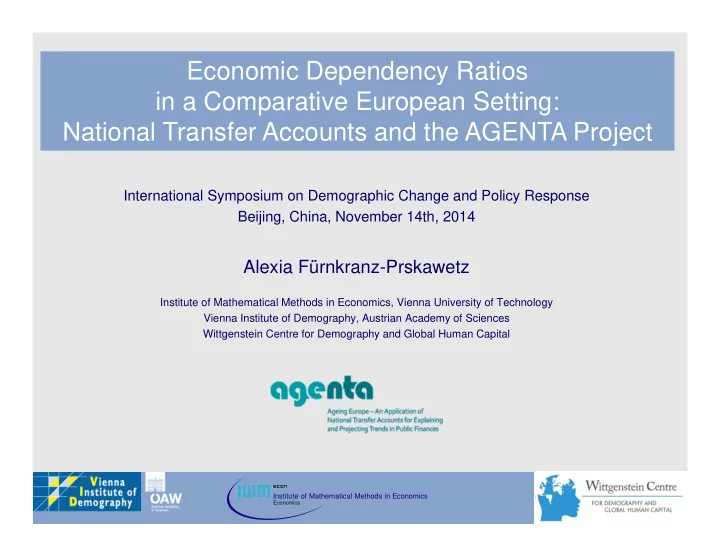

Economic Dependency Ratios in a Comparative European Setting: National Transfer Accounts and the AGENTA Project International Symposium on Demographic Change and Policy Response Beijing, China, November 14th, 2014 Alexia Fürnkranz-Prskawetz Institute of Mathematical Methods in Economics, Vienna University of Technology Vienna Institute of Demography, Austrian Academy of Sciences Wittgenstein Centre for Demography and Global Human Capital Institute of Mathematical Methods in Economics Economics
Europe is Ageing 2013 2060 < 15: ~ 15% 15-64: 66% 57% 65+: 18% 28% 80+: 5% 12% Source: The 2015 Ageing Report, graph I.1.2 Institute for Mathematical Methods in Economics Economics
Demographic Dependency ≠ Economic Dependency < 20 + 65+ ≠ 20–64 Non-working workers Non-working: (children + unemployed + housewives) – ( men + retirees + other inactive) Working: full-time, part-time, compulsory military or civil service Institute for Mathematical Methods in Economics Economics
Employment-Based Dependency 2011 Source: EU-Silc 2011, EUROSTAT Institute for Mathematical Methods in Economics Economics
Economic Dependency from a Lifecycle Perspective: NTA Dependency Ratio Need to consider also degree of dependency within dependent population degree of economic ability of those who support others age-specific difference of average consumption and income based on NTA Institute for Mathematical Methods in Economics Economics
Life Cycle Deficit: Comparative European Setting 24(A) – 27(I) 58(Sl) – 64(SE) Institute for Mathematical Methods in Economics Economics
NTA-Based Dependency life cycle deficit of young and elderly life cycle surplus of adults Institute for Mathematical Methods in Economics Economics
NTA-Based Dependency 2011 2.60 IT 2.40 UK 2.20 NTA based dependency 2.00 1.80 FI FR ES HU 1.60 DE 1.40 AT SE 1.20 SI 1.00 1.00 1.10 1.20 1.30 1.40 1.50 1.60 1.70 1.80 Employment based dependency Source: EU-Silc 2011, NTA Institute for Mathematical Methods in Economics Economics
Forecasts of Employment-Based Dependency Institute for Mathematical Methods in Economics Economics
Forecasts of Employment-Based Dependency Institute for Mathematical Methods in Economics Economics
Forecasts of NTA-Based Dependency Institute for Mathematical Methods in Economics Economics
Covering Stages of Dependency NTA Austria Consumption Labour income Asset Reallocation Private Transfers Public Transfers Institute for Mathematical Methods in Economics Economics
Unpaid Work: The Life Cycle Deficit by Gender Women produce more non-market goods and services than they consume except during teen ages The life cycle deficit is very low for men and stays positive over the whole age range in the case of Italy Institute for Mathematical Methods in Economics Economics
Total Life Cycle Deficit by Gender Gender differences are lower compared to only using NTA High contribution of women to production in Slovenia and Spain Institute for Mathematical Methods in Economics Economics
Conclusion/Discussion Consequence of population ageing is not just determined by demographic change but to a large extent by the shape of the economic lifecycle LCD is a new measure of dependency that takes into account age- specific levels of production and consumption To maintain the fiscal sustainability of the current public transfer system in many European countries requires changes in the shape of the average economic lifecycle Reforms of the transfer system need to take into account not only public transfers but also private transfers , particularly those in form of services to other household members through unpaid work Institute for Mathematical Methods in Economics Economics
AGENTA Ageing Europe – An Application of National Transfer Accounts for Explaining and Projecting Trends in Public Finances (FP 7 Collaborative Research Project, no. 613247) http://www.agenta-project.eu/en/about-agenta.htm Institute for Mathematical Methods in Economics Economics
Thank You Institute for Mathematical Methods in Economics Economics
Recommend
More recommend